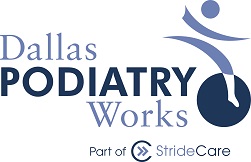Kids should get orthotics when they’re experiencing regular discomfort in their feet, especially when walking. Our doctors at Dallas Podiatry Works evaluate children’s lower limbs to determine what could be causing their pain. A variety of pediatric conditions, like flat feet and Sever’s disease, can be corrected and relieved by adding custom orthotics to your child’s shoes. The prescription inserts add stabilization and help reduce pressure on kids’ feet.
Very young children who are just learning to walk probably won’t require orthotics, since they need to naturally build their lower limb strength and stability; however, slightly older children with frequently painful feet may be candidates for the prescription inserts.
Sever’s disease is a common pediatric condition among young athletes. It’s heel pain caused by inflammation in the calcaneal growth plate. Kids’ feet tend to experience growth faster than the rest of their bodies, causing some tightening in the Achilles tendon. Active children put additional stress on the tissue, which then pulls on the heel bone. This irritates the growth plate and causes discomfort. As an overuse injury, the condition tends to worsen over time if not treated.
Adults or older teens who have finished growing don’t have this problem. Once the plate seals and fuses to the rest of the heel, it can no longer become inflamed. Fortunately, your child won’t have to wait that long to find relief from the discomfort. Many conservative treatments are very successful in eliminating the pain.
It takes several years for children to develop enough strength and balance to walk the same way adults do. Still, an abnormal gait in a young child could be the result of problems like intoeing, out-toeing or toe walking. Intoeing and out-toeing involve the abnormal inward or outward rotation of the feet. Toe walking occurs when the Achilles tendon is too short, making it difficult for the child to place his or her feet flat on the ground. You should have an expert evaluate your little one’s feet and ankles to check for underlying pathological causes that may need care. Fortunately, these problems are usually treated easily or the child grows out of them on their own.
Parents understand the importance of keeping their kids healthy.
Yearly check-ups, vision screenings, and dentist appointments are all part of a child’s regular medical care. If something goes awry in between regular appointments, you visit the appropriate provider. Your podiatrist is the go-to person if your child is experiencing foot pain.
The feet are vital to everything that we do, and are especially important for active children. Growing pains are a part of childhood, but foot pain is not normal. If you notice a decline in activity, limping, or an abnormal gait, you should call Dallas Podiatry Works immediately. Your doctor will examine your child’s feet and determine the best course of action.
Some symptoms in the feet are indicators of a more serious illness, but many common childhood foot conditions are easily treated. Don’t spend another day worrying about your child’s foot health.
Dallas Podiatry Works strives to provide you and your children with the best care and treatments possible.
The goal of orthotics is not to fix a child's flatfoot deformity. The goal is to accomodate the deformity and allow your child to function actively with less or no pain in their feet, ankles, or legs.
Until your baby begins to walk, shoes are not necessary at all. You can choose booties or slipper socks to keep feet warm during the winter months. As your child learns to walk, feeling the ground with his or her bare feet is helpful.
Shoes are really only necessary as protection for the feet. Keep this in mind when purchasing shoes, and look for materials that are soft and breathable. It’s also important that the shoe you select has a sole that won’t slip on surfaces that are smooth.
When shoe shopping for your toddler, consider the fit. If the heel isn’t snug, the foot will move forward with each step. Make sure that there is enough room for the toes both in length and width of the shoe. Also, shoes should be flexible enough to bend near the base of the toes, just as your foot does.




